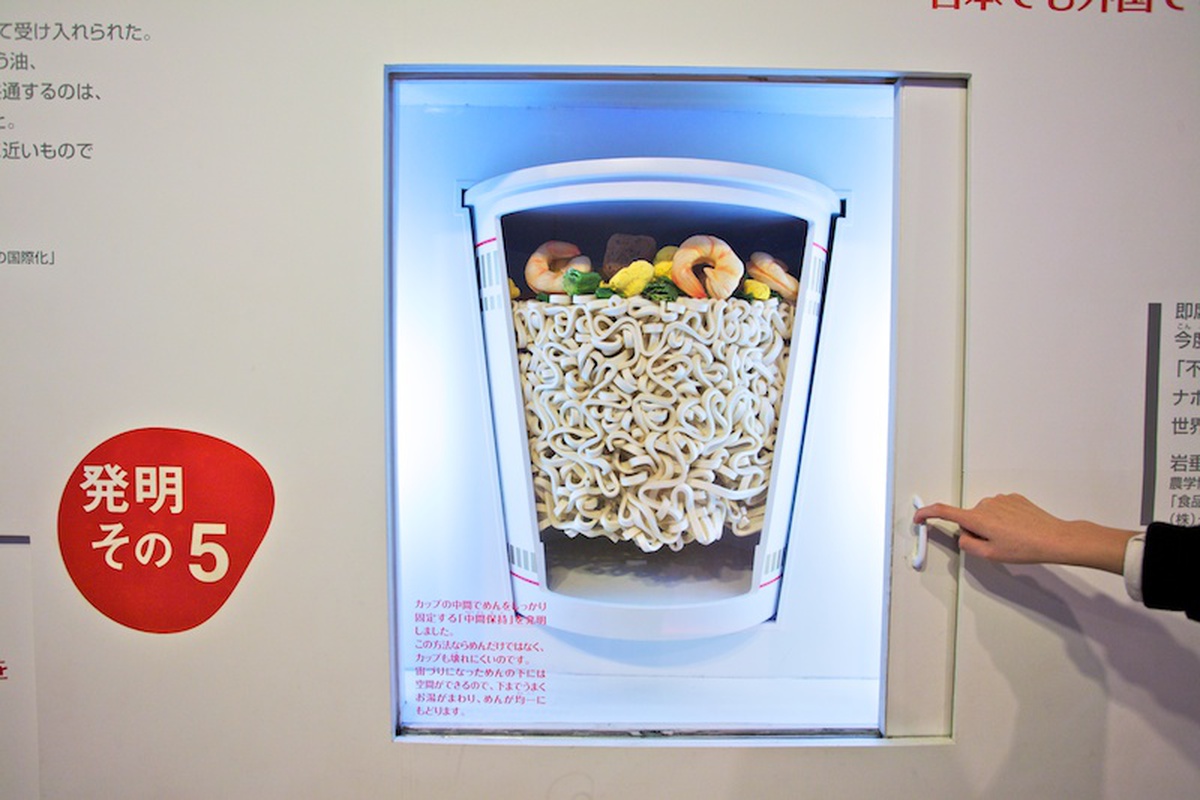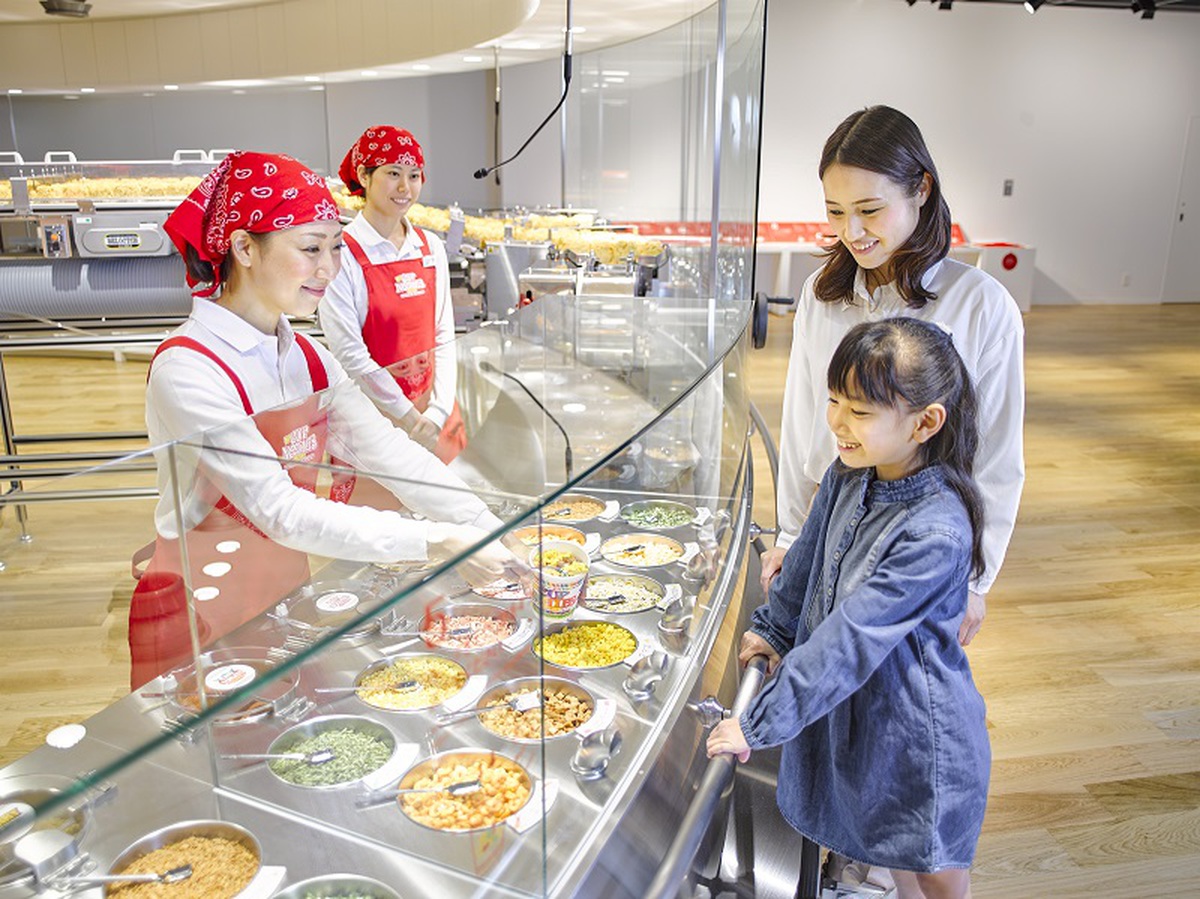
Let's go to the CUPNOODLES MUSEUM OSAKA IKEDA !
No explanation about instant noodles, or instant ramen, is needed, since we are all highly familiar with them. Instant noodles are the perfect solution in all kinds of daily-life situations, providing quick between-meals or late-evening snacks, and overtime or emergency meals. They have already become indispensable in our lives. Japan's domestic annual consumption has reached 5.4 billion servings (in 2014; according to the Japan Convenience Foods Industry Association). This means that annual instant noodle consumption per capita is 42.4 servings; in other words, every one of us eats them three to four times a month on average. I'm sure that we can now call instant noodles our national food!

Japan, of course, is not the only nation where instant noodles are very popular. The global annual consumption of instant noodles amounts to 102.7 billion servings! I cannot imagine this astronomical amount, but I believe that we may call instant noodles even "global" food, because they are eaten almost every country throughout the world; even astronauts now take instant noodle products into space! In fact, I keep at least five instant noodle packages always in stock in my house. They are indispensable to me. How many times have I been helped out by instant noodles? When, for example, if I come home late or I am short of money, they are a great help. Who on earth invented this incredible food?

Today, I will introduce to you the "CUPNOODLES MUSEUM OSAKA IKEDA ," located in Ikeda City, Osaka. As a matter of fact, Ikeda City is the birthplace of instant noodles. In 1958, the world's first instant noodle product, "Chicken Ramen," famous for its TV commercial, originated in a "Research Shed" in Ikeda City, in the yard of the house of Momofuku Ando, the inventor of instant noodles and the founder of Nissin Food Products Co., Ltd. The CUPNOODLES MUSEUM OSAKA IKEDA was established in 1999 to introduce the history of instant noodles and convey the significance of innovation and discovery in the stages of invention.
In the Museum, you can not only learn about the creation of instant noodles, its history of development and its manufacturing methods, but also you can create your own cup noodle with soup and ingredients of your choice at "My CUPNOODLES Factory" (no reservation required/subject to fees) and make Chicken Ramen by hand at the "Handmade Chicken Ramen Hands-On Workshop" (advance reservation required/subject to fees). I have heard that these features are very popular. Apparently, they are a lot of fun!
Birth of instant noodles to "2005: A Space Odyssey
TheCUPNOODLES MUSEUM OSAKA IKEDA is a five-minute walk south from Ikeda Station of Hankyu Railway Takarazuka Line. You can easily find the Museum by following the so-called "Men Road." ("Men" means noodles in Japanese). In front of the building is a bronze statue of Momofuku Ando, the inventor of instant noodles, smiling with a package of Chicken Ramen in his hand, standing on a Cup Noodle-shaped pedestal. Let's go inside the Museum, after picking up a facility map and other material at the well-lighted entrance.
Work Shed where the "magical ramen" was invented

The first thing you see is a replica of Mr. Ando's "Work Shed." To all appearances, however, it looks like an ordinary wooden hut, just like in "The Three Little Pigs" or other fairytales... Outside you can see a bicycle, said to have been used to convey wheat bags on its carrier, and a replica of a chicken used for soup. The scene where noodles are spread and dried is reproduced at the entrance. The shed is about the size of a four-and-a-half mat room (approximately 7 sq. meters), with a naked light bulb, a pendulum clock and common kitchen utensils found in any house, including a Chinese frying pan, a bowl, a scale, a ladle, a bamboo sieve and a steamer. I had imagined that instant noodles were invented with much more advanced technology, so I was amazed to discover that they were actually born in a "kitchen" like this. I heard that Mr. Ando devoted himself to development of instant noodles for a whole year in this Shed, hardly even allowing himself time for sleep.
Mr. Ando aimed to create a noodle product that "can be easily eaten anywhere at any time and kept in stock at home"; one that "can be eaten instantly, requiring only hot water." In the Research Shed, you can see evidence of various approaches that were taken in development. For example, a large watering pot was used when pouring finished soup on noodles to flavor the noodles evenly. Then, a serving of flavored noodles was put into a hand-made wire-netting strainer to be fried in oil in a large Chinese frying pan, then instantaneously dried. (You can watch noodles being fried in a pan on screen and hear them sputtering.) He was inspired to visualize this process by the tempura that his wife made. The deep-frying process extracts water from the noodles, drying them and creating many pores in the noodles (like deep fry batter). Noodles can be kept longer by drying, but when hot water is poured onto them, the hot water soaks into the pores, restoring the noodles to their original state instantly. This is the way instant noodles work.

By the way, why was the soup made from chicken? One day, one of the chickens kept close by the Shed suddenly went into frenzy while the chicken was being cooked, and Mr. Ando's little son saw that and became frightened. As a result, he became unable to eat chicken. However, he liked soup made from chicken stock. Mr. Ando, therefore, decided that the soup for his instant noodles should be chicken-flavored. Mr. Ando later said that there are no countries in which people do not eat chickens and thus chicken flavor has been universally accepted.
In 1958, the world's first instant noodle product, Chicken Ramen, was completed. Chicken Ramen, which could be eaten just by adding hot water, was called "magic ramen" in those days. Chicken Ramen is "easily cooked," "can be stored without refrigeration," "is reasonably priced," "is sanitary and safe," and, on top of all that, "it's tasty." These are all aspects of the "magic" of Chicken Ramen. The "magic ramen," created by Mr. Ando, is now popular throughout the world, and has been called one of outstanding inventions in the 20th century, having changed the diet of people throughout the world.
History of instant noodle development
Leaving the Research Shed, I moved past some exhibits on the white wall on the left side. These exhibits introduce the history of instant noodle development, including how instant noodles spread after Mr. Ando created the first instant noodle product, and how instant noodles have been accepted and eaten by people throughout the world, and visitors can learn about these facts through images, photographs and utensils that were actually used.
Chicken Ramen appears!

Let's begin with thinking "why noodles?" On the monitor are pictures of towns taken soon after World War II. On a winter night soon after the war, Mr. Ando saw people forming a line more than 20 meters long in front of a noodle stall at the black market in Osaka. He was surprised that people would make such great efforts for only a bowl of noodles in the cold and became convinced that food is very important for people. This feeling eventually led to the development of instant noodles.
Mass production of instant noodles

Chicken Ramen was made by all of the family members at first. Mr. Ando's wife made soup, his children helped their parents with packing and all of the members bagged the packed noodles, which were distributed by the family members. One day, at a tasting event held in a department store in Osaka, Chicken Ramen caught the interest of homemakers! The product achieved great popularity, as it can be made just with hot water. Mr. Ando, who had a positive response at the event, would like people throughout Japan to eat this product and built a plant, aiming to mass-produce Chicken Ramen through full automation.
Cup Noodle appears.

Mr. Ando visited U.S.A. with Chicken Ramen, aiming at spreading instant noodles to other countries. Americans, of course, were deeply interested in Chicken Ramen. However, there was a problem. There were neither appropriate bowls for noodles nor chopsticks in the U.S.A. As a result, an American buyer split the noodles of Chicken Ramen, put them into a paper cup and poured hot water into the cup, and then began eating them with a fork. It was just at that moment that Mr. Ando hit upon a good idea... "noodles in a cup"! After that, "Cup Noodle" was originated in 1971. This is surely an ultimate instant noodle product, which can be made only with hot water.
Other ideas of Mr. Ando's also took shape. One example is the pack structure of "Middle Suspension", where noodles are suspended in the middle of the cup. This helps prevent both the noodles and the cup from being broken during transportation because the noodles are closely attached to the cup, and allows even dehydration of the noodles because poured hot water can circulate from the bottom of the cup. Another idea is using film for the lid. He was inspired to think of this by a macadamia nut container provided on board an airplane. I was really convinced that he exercised his ingenuity in great detail in creating Cup Noodle.
Becoming global food
In this way, instant noodles came to be eaten also in foreign countries. The next section clearly shows you how broadly instant noodles have spread throughout the world. On the large world map on the wall, the annual total demand of instant noodles by nation is shown with red Cup Noodle marks. For example, the U.K. is 3.8, Nigeria is 15.2, Vietnam is 50.0, the U.S.A. is 42.8 and China is 444.0. The unit is 100 million.

Packages of instant noodles from around the world were also exhibited, including those that are tomato-flavored, creamy-type, full of vegetables, and spicy. They are made according to each nation's climate and people's sense of taste. By the way, I have eaten Thai tomyamkung-flavored instant noodles, which were nice with hot, acid taste.
Instant noodles launches into outer space

On July 26, 2005, the space shuttle Discovery was launched successfully. It was the world's first instant noodle product launched into outer space, "Space Ram," that took off with Japanese astronaut Soichi Noguchi on Discovery. There were four flavors: soy sauce, miso, curry and tonkotsu (pork broth). It was specially made to be edible using hot water at 70˚C, which is the boiling point in outer space. Even under weightless conditions, which change people's sense of taste, it tastes as good as on earth; Mr. Noguchi said that he truly enjoyed the earthly taste that was reproduced to a startling degree. Eating noodles in the shuttle, Mr. Noguchi looked very happy. You can see a photograph of the neighborhood of the Museum, taken from outer space, that Mr. Noguchi brought to the Museum after returning to Japan. I could not identify the Museum on the photograph; however, please look closely at the photograph, where the Museum is indicated by the arrow of "Here.
To their fathers, I recommend looking at "Traces of Momofuku Ando," where Mr. Ando's photographs, medal awards, a manuscript of New Year's remarks in his own hand and other testimonials are exhibited. You can look at "Sayings of Momofuku," a collection of many wise remarks, including "A culture can only prosper when its people have enough to eat," and Asian-version of TIME featuring "Asian Heroes in 60 Years," where Mr. Ando was introduced as an Asian hero.
Specialties of the Museum: your original Cup Noodle and hand-made Chicken Ramen
Next I finally reached today's main event: Let's make instant noodles. In the Museum are "My CUPNOODLES Factory," where visitors can make their original Cup Noodle by selecting their favorite soup flavor and ingredients, and "Handmade Chicken Ramen Factory," where visitors can make Chicken Ramen from wheat. Both are enough to excite my enthusiasm! Let's go!

First, I went to the My CUPNOODLES Factory, located at the end of the Museum. The Factory was crowded with groups of young people, couples, families, etc. I also saw many tourists from other Asian countries, including China. In this corner where visitors can make their own Cup Noodle by, for example, drawing pictures by themselves on the famous Cup Noodle container and selecting favorite ingredients of their choice. Let's begin!
The first step was buying a Cup Noodle container from the vending machine. It costs 300 yen per container. You can buy as many containers as you want. The woman behind me bought three containers! After buying a container, you must wash your hands. I see! What will be made is a food product, so sanitation comes first.

Then, you can freely design the space on the middle of the container using color pens. When I glanced at the participants around me, a person was drawing a colorful flower, another was copying Hiyoko-chan, the symbol character of Chicken Ramen, and another was drawing a never-seen-before mystery organism... What could I do? I knew that I was a poor painter. After much thought, I wrote a thick "U-Ma-I" (meaning tasty) with a green pen. I'm sure that it is tasty, so it was O.K. for me; however, I myself was amazed at such a direct approach as this.
Undiscouraged, I took my package to the counter. Then, one of the women behind the counter received it with smile and placed it on the machine that puts noodles into the container. However, I had to operate the machine by myself. After I turned the lever clockwise six times, a bundle of noodles dropped into the container just as I had seen in the exhibition previously. Now I can experience the importance of "turning things around".

The next step was selecting the soup flavor. You can select one of the four flavors: regular (soy sauce), seafood, curry and Chili Tomato. For your reference, seafood or Chili Tomato is popular in women and regular or curry is popular in men. I selected the regular flavor, which I believe is the most ordinary. A staff member recommended curry with cheese, which is rich in flavor.

The next was selecting ingredients. You can choose four of the 12 ingredients, including freeze-dried shrimps, crab-flavored fish sausage, Chinese-style barbecued pork, cheese and corns. Taking this opportunity, I chose Hiyoko-chan illustrated naruto (boiled fish paste) which was not for sale, the limited time special ingredient, asparagus and egg. It was fun to select ingredients while imagining the taste after they were mixed. After the container was sealed, packaged with films and boxed into the "air package," My Cup Noodle was completed. I hesitate to say this, but the design of "U-Ma-I" was appropriate, because it was surely tasty.

If you become hungry while making Cup Noodle, go to the Tasting Room. There, visitors can buy rare noodle products that are sold in limited areas and not available in Kansai, and ones that are served only in the business or higher class (airplane-illustrated naruto is in it) from vending machines. I heard that eastern Japan and western Japan differ in the soup flavor of Donbei Kitsune Udon noodle products. Both versions are sold there, so why don't you compare them? You can eat noodles in a room with a view of the inner court while remembering various difficulties and devices that you learned at the exhibition. (You cannot eat the noodles that you made at the My CUPNOODLES Factory or the Chicken Ramen Factory. Details are subject to change.)
Chicken Ramen Factory

At around 2:25 in the afternoon I went to the Chicken Ramen Factory on the second floor. Participants sat at tables, separated into several groups in the large room like a cooking laboratory. I joined a group of four nurses from Kyoto, a third-grade schoolboy and his mother and two senior men living in the neighborhood. Each participant wore an apron and a bandana that were provided. All wearing Hiyoko-chan illustrated bandanas, regardless of age and sex, participants looked very pretty. After receiving a brief explanation, we went to the work tables.
First of all, we put powder (flour mixed with yam and vitamin powder) into the bowl and added kneading water (brine and salt) while quickly mixing it with our fingertips. Small lumps formed gradually. Then, we continued to knead the dough until a fist-sized lump was formed. While we were kneading the dough, staff members cheered us up, gently saying, "Hurry, hurry. Knead, knead." This process exhausted me!

Next, we rolled out the dough. Since the dough was harder than I imagined, this process, requiring me to put my weight on the rolling pin, was pretty difficult. I realized that noodle-making requires much power. When the dough became around one centimeter thick, we put the dough into the noodle-making machine. We let the dough pass through the rollers to smooth it by turning the lever, not one or two times, but around ten times. This is similar to the process for making udon noodles, to make the noodles chewy by pressing their dough. My right arm felt heavy and sweat appeared on my forehead.
Then, the dough was left alone to mature for a while. Meanwhile, we designed a package. I tried to make a stylish design this time; however, what I finally drew was a steaming noodle bowl with a words balloon saying "I made it." Ah, what a pity!

Then, we put the dough that had matured for a while through the noodle-making machine again until the dough became 0.7 millimeters thick and 2 meters long. The next process was cutting the dough into noodles. With scissors, we cut the noodles that were made thin with the cutting edge of the noodle-making machine. The most suitable length for slurping noodles is 20 centimeters. Then, we weighed out servings of 100 grams of noodles, using scales.

Now, noodles were done. While staff members were steaming the noodles, we resumed making our package designs. On the package of the schoolboy sitting across was the phrase, "3 minutes with hot water, 1 minute in a pot, Chicken Ramen." Its powerful letters impressed me. The nurses next to me drew snowball-like images of Hiyoko-chan and Hiyoko-chan taking a bath. Their packages were colorful and pleasing. I added orange stripes in the background, borrowing their style.
Meanwhile, the steaming process for noodles finished, and a staff member poured the soup on the noodles with a ladle. Then, we stirred the noodles with our fingers, following instructions of staff members saying, "Stir them quickly. Mix them quickly." As we were told to stir the noodles well so that they can take on the flavor of the soup evenly, we all were mixing the noodles with the soup without a word.

The noodles were put into the mold and finally put into oil at 160˚C. Because it is difficult and would be dangerous to fry noodles, a staff member did this process. The noodles were becoming brown in oil with spluttering sound through the "Flash-frying method," which had been used since the method was invented by Mr. Ando. It was nice and impressing to see that live. The noodles were done at last! We had a staff member pack the noodles in the package that we designed before, and it was completed. The orange stripes looked good.
It took 90 minutes. The time passed very quickly. I enjoyed transforming mere wheat flour to noodles gradually. The nurses sitting next to me, too, seemed to enjoy this experience, saying, "I had a very good time," "It was fun making this by myself," and "It is easy to eat noodles, but it is hard to make them." I agreed with all of their remarks.

By the way, an advance reservation is necessary to make Chicken Ramen at the Chicken Ramen Factory. The participation fee is 500 yen for junior high school students and older and 300 yen for elementary school students. Intended participants are all visitors from elementary school student age up, and parental guidance is required for third grade children and younger.
Instant Noodles Tunnel
Taking the "My Cup Noodle" and "Chicken Ramen" that I had made, I went through the Instant Noodle Tunnel to leave the Museum. In the Tunnel, product packages of various Nissin's instant noodle products from the first Chicken Ramen in 1958 to the present are displayed in chronological order. Approximately 800 types of packages were displayed. You can see, through the display, that a curry-flavored product and a pan-fried noodle product were already launched - only a few years after Chicken Ramen was put on the market.

A man stopped in front of the display of Cup Noodle in 1971. I wondered whether he was remembering his childhood. I could understand that visitors cannot help but time-trip when seeing the transition of instant noodle products on display. I remembered that when eating Nissin UFO Yakisoba noodles, I waited for three minutes while dancing to a Pink Lady song (I am afraid that I am showing my age), and that when studying for an examination, I ate udon noodles packaged like this. The display of instant noodle products tends to make us recall past experiences. Near the exit was the display of latest products. Various new products reflecting the times, including an instant noodle product with a reusable eco-cup, appeared. I was impressed by the fact that instant noodles, which became widespread in our daily life to this degree, are moving forward to the future with us.
Enjoy a little history walk in Ikeda, the birthplace of instant noodles

Ikeda City, located in the northern part of Osaka Prefecture, has flourished as a key place for distribution from olden days. The Nose Highway, which runs from north to south through the City, connected the Hokusetsu region (northern part of Osaka) and Nose and Tamba, located way up north, with a large city Ozaka (present Osaka) and was busy with people who transported lumber, clothes, liquor and other products. When seeing sake breweries of Goshun and Midoriichi (both are names of sake) that continue to make high-quality sake in areas where old stores and houses still remain, you can find vestiges of the old days. In the "Rakugo Museum", you can envisage Ikeda in Edo Period through rakugo (Japanese traditional comic stories) of the Kyoto-Osaka area whose setting is in Ikeda like "Ushihome" and "Ikeda no shishi kai." I recommend taking in the view of Ikeda City, once called the north capital, from Ikeda Castle Site Park, located on top of a small hill.


